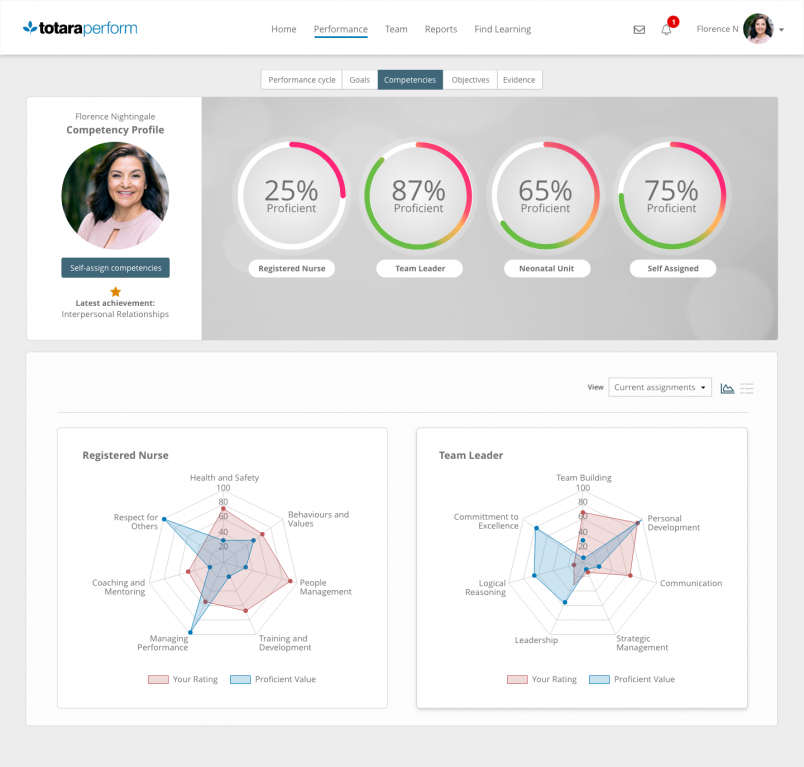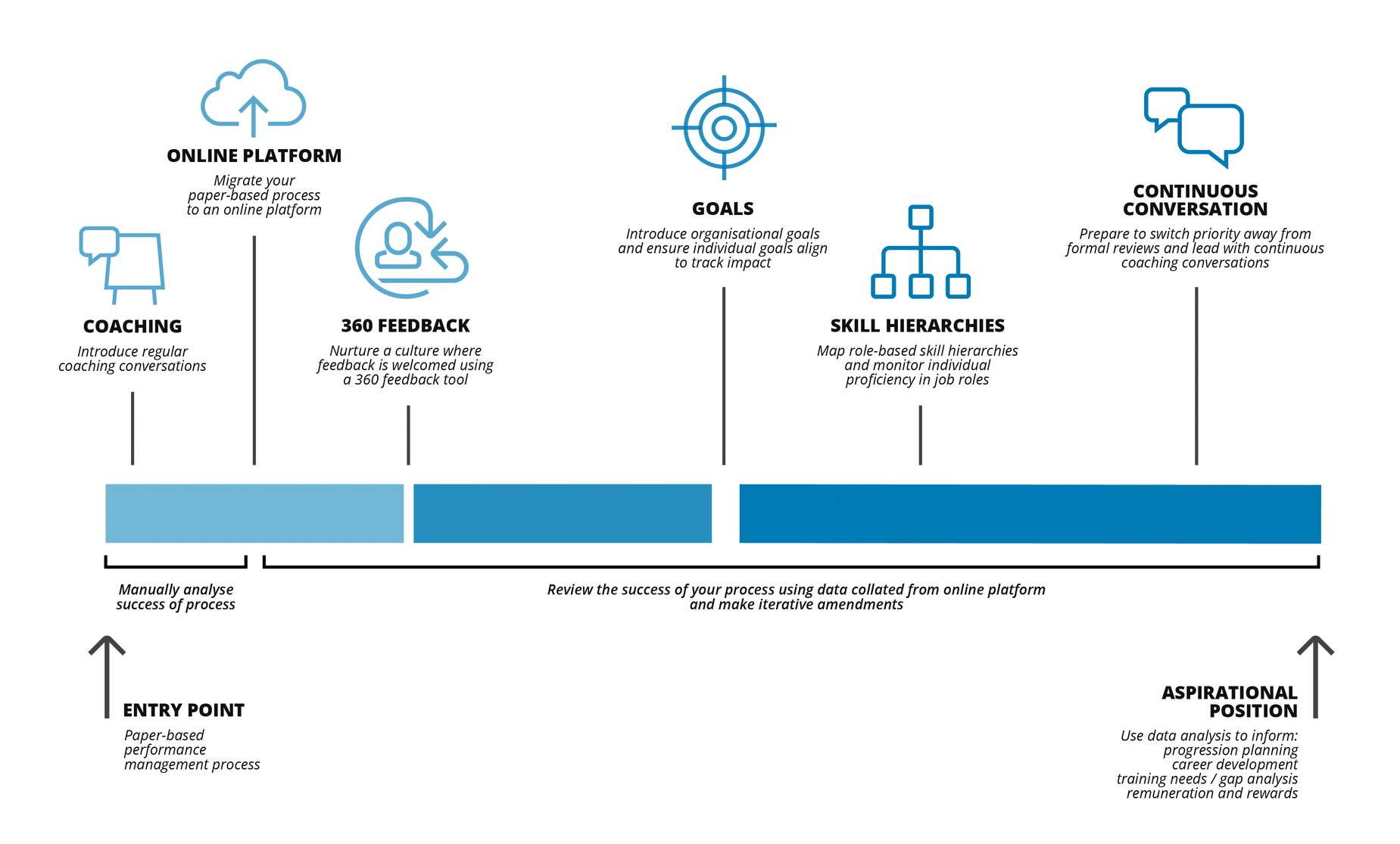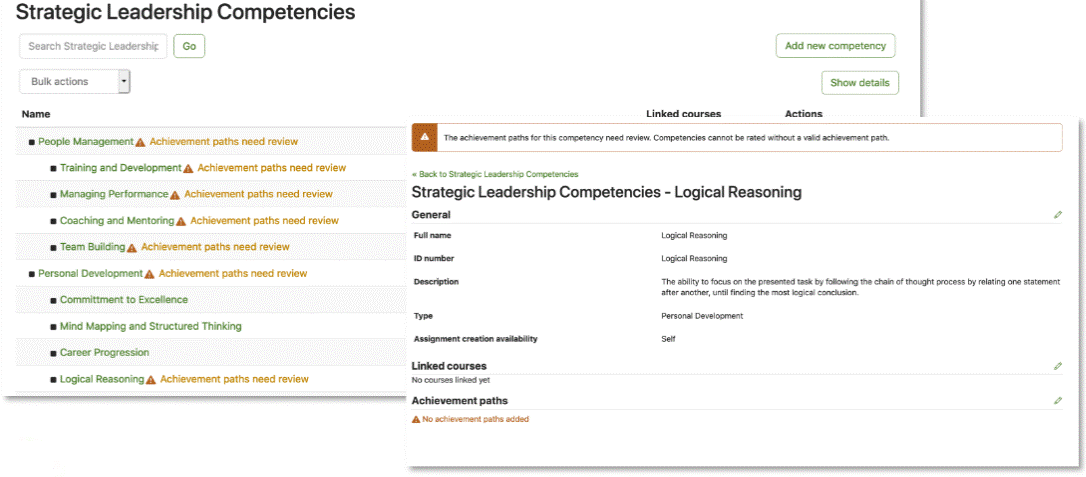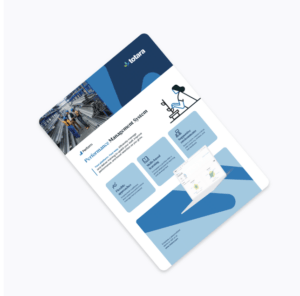Effective performance management in government agencies (or the public sector in general) can be challenging due to the size, complexity and multi-layered nature of government organizations.
In this guide, you’ll learn 4 ways to improve performance management in the public sector to boost workforce engagement, retention and productivity.
Table of contents:
1. Focus on change adoption and management

When improving an existing performance management process, initiatives are prematurely stifled because the adoption process is either non-existent, too drastic, or over-complicated and time-consuming.
There’s no need for a radical uprooting of your existing government performance management processes.
Practices and procedures should be introduced gradually, as aggressive changes can backfire by overwhelming employees, bloating initiatives and making it harder to gain buy-in from stakeholders.
Implement the following gradual improvements to make progress:
1. Secure buy-in.
If you’re involved in improving your organization’s performance management process, buy-in from senior management/leadership will accommodate necessary improvements or changes.
Communication and testing the waters is essential, so avoid announcing or actioning drastic changes without consulting or informing other managers and frontline employees.
2. Choose technology that grows with your organization’s needs.
As your organization’s size changes and requires more resources to meet public needs, the demand for employee development and management grows and changes in tandem.

(Totara Perform does not force you to adopt a specific workflow, style or way of doing things. Your organization is free to innovate and incrementally improve elements of your program at its own pace.)
That’s why we suggest choosing adaptive employee performance management software, like Totara Perform, that’s capable of securely connecting learning, performance management and collaboration for large, diverse organizations.
Thanks to its robustness and adaptive nature, Totara software is trusted by the USDA to accommodate 140,000 end users, 30 unique agencies and over 2,000 administrators.
3. Experiment
Roll out changes to a single unit or department within your organization and measure the results. Feel free to test different iterations of a new performance management process – like experimenting with monthly vs weekly performance check-ins.
2. Connect performance management to talent development
Having a central system for tracking employee feedback, goal setting and connecting learning to performance data will:
- Strengthen strategic management plans
- Help identify and fill critical skills gaps
- Lay the foundation for a practical, employee-friendly performance management framework
Using a performance management system like Totara Perform—which supports both traditional and continuous performance management —the process of building robust compliance and competency structures across all divisions and positions within an organization is streamlined.
Competencies can link to courses, roles and learning plans, which connects the dots between employee development, management and performance.
This also eases the challenges associated with identifying quantifiable skills or behaviors that employees need to effectively perform (and progress) in their roles.
Managers, for example, can assign a “rating” (such as Beginner, Improving or Expert) to each competency in an employee’s development plan. Ratings and competencies can then be supported with real-world evidence.
(Evidence types are configurable and include training completed in an LMS like Totara Learn, noted behaviors in day-to-day roles, certifications, badges from previous roles and more.)

Recommended read: How government agencies can engage employees with training
3. Engage public sector employees with succession planning
It’s no secret that the US government struggles with hiring and retaining employees.
The median age for US public servants is now 45.6—which is higher than almost every other American workforce. Lengthy hiring times are also not helping (the Federal Government takes 3x longer to hire employees when compared to the private sector).
With staff retirement numbers expected to rise in coming years, this leaves government agencies with a dilemma on their hands:
How can agencies attract and retain millennial and gen Z employees, and plug the looming staffing shortages with new workers?
One two-pronged solution is to combine better career progression to retain employees and succession planning to prevent skills gaps.
In a broad sense, this means supporting a culture of mentorship, collaboration and development between senior employees approaching the end of their tenure or retirement age, and junior employees entering the government or public sector workforce.

A learning experience platform (LXP) is a powerful tool for establishing such a culture because it can support employee knowledge sharing and encourage development at every stage of an employee’s career.
From brand-new employees to experienced senior management, an LXP connects people with similar learning needs—whether that’s by role, location, seniority level or skill set.
Not only will this help your people share knowledge, collaborate on projects and communicate with colleagues, but it also opens up the opportunity for developing employees to be mentored by senior experts.
Experts can curate training resources from multiple channels to create personalized development paths, answer questions from mentees and track how engaged mentees are.
This provides employees a dedicated place to develop their skills, discuss ideas with colleagues and solve problems together in an engaging and interconnected way.
And with more government employees expecting to keep working remotely in a post-pandemic world, an LXP also acts as a central collaborative online workspace for complex tasks and projects:
-
Wikis help employees navigate policies, governance or independently troubleshoot and self-serve issues
-
Forums document deep discussions, facilitate valuable team brainstorming, stimulate new ideas and enable peer reviewing
-
Surveys help efficiently capture ideas and sentiments from large groups of people
-
Content playlists can be assigned to foster continuous learning and upskill employees on specific subjects or competencies
-
Badges and labels gamify knowledge sharing, reward subject matter experts and recognize frequent contributors
4. Align your agency’s technology, systems and culture
One key challenge that government agencies face is a lack of alignment and integration between their core systems.
A single agency can have constituent organizations with multiple learning management systems, performance management processes and various collaborative platforms.
This encourages organizational silos, dilutes communication and significantly increases duplication of effort across the board.
Fortunately, government agencies have the ideal solution in Totara’s Talent Experience Platform (TXP).
The platform comprises three individual systems, which combine to support learning, engagement and performance management:
1. Totara Perform – the adaptive performance management system that allows you to efficiently manage competencies, streamline development programs, establish critical employee performance goals, get 360-degree feedback, connect learning and development to performance management, and much more.
2. Totara Learn – the learning management system (LMS) trusted by millions of learners and favored by companies worldwide to deliver transformational learning, meet stringent compliance requirements and enable reporting to key stakeholders.
3. Totara Engage – the learning experience platform (LXP) built to engage, unite and upskill your workforce. Totara Engage empowers employees to simplify complex knowledge sharing with permanent workspaces, content playlists, a Microsoft Teams integration and more, to nurture deep collaboration and job-relevant learning.
Together, these intuitive systems (that integrate with your current HR, HCM and L&D tech) empower you with a Talent Experience Platform that improves every aspect of your employee-employer experience to unlock peak performance and boost workforce productivity.
Author bio: Hassan Uddeen is a freelance content strategist and SEO consultant specializing in HR and B2B content marketing






